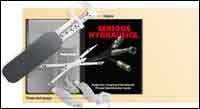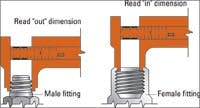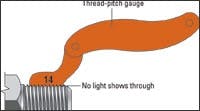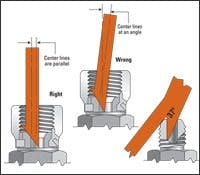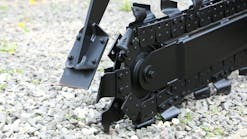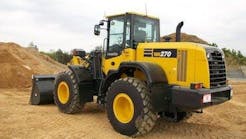Leaky hydraulic systems cost so much to maintain that many equipment managers have made leak-free couplings one of their top maintenance concerns. It's easier said than done, but with attention to matching replacement fittings to those on the machine, and proper installation, you can keep a relatively dry fleet.
Couplings have two functional ends, the hose end and the port (or "thread") end. Both ends must match the size and type of port or hose with which they're mated. With nearly two dozen types of couplings in use, it's not always easy to identify the ones on your equipment. Gates' Safe Hydraulics booklet has extensive information, including drawings that identify coupling types. The booklet is available to attendees of Gates Safe Hydraulics seminars.
O-ring face seals are gaining such popularity that they may eventually become a standard of sorts. But different countries, and even some manufacturers, insist on unique coupling designs. Kevin Dugan, fluid power systems engineer at Parker Hannifin, says Parker would prefer to standardize on the SAE-Straight Thread (SAE - J1926), the ISO 6149 (SAE - J2244) metric port thread, or the Code 61 / 62 four-bolt split flange. "But with the differences between North American and overseas manufacturing, standardization is difficult." The number of older couplings still in use on aging machines compounds the problem.
Fortunately, suppliers offer measuring kits to take the guesswork out of identifying fittings. You'll find the fundamentals of identifying fittings in the illustrations accompanying this story.
Properly matching couplings is the indispensable start to maintaining hydraulic-system integrity, but assembling the joints correctly is just as important. Proper torque is one key. Even if a poorly torqued coupling doesn't leak, other problems may occur. A 37-degree coupling that has been over-tightened may deform, restricting flow and causing turbulence in the hydraulic fluid. Restriction and turbulence generate heat and reduce system performance.
Dennis Kemper, applications engineer with the Gates Hose & Connector Group, says that over-tightening can cause as many problems as too little torque. Too much torque can strip threads, distort the fitting, and scratch or crack the cone or seat. "Any of these conditions will prevent proper sealing."
Kemper emphasizes the importance of preserving the torque spec. "A hose that was twisted during assembly will want to straighten out when system pressure is applied. This can result in hose failure or loosening of connections, which is sometimes referred to as 'de-torquing.' The use of a backup wrench while tightening swivel fittings will help prevent twisting.
"Service personnel should always take into account the manufacturer's minimum bend radius for the hose," says Kemper. "And avoid routes that twist the hose or cause it to bend immediately behind the coupling."
Couplings must also be inspected thoroughly if you want to stop leaks. Caterpillar's Guidelines for Reusable Parts and Salvage Operations (Media Number SEBF8176-01) discusses which parts can be reused and which defects can be repaired. In general, couplings with minor nicks or burrs can be reconditioned, but more serious damage—to sealing surfaces or threads, distorted flange faces, cracked or distorted stems or swivel nuts, or any part that has been welded or subjected to high heat—reduce the coupling to scrap.
Gates' recommendation is more stringent. "No coupling should be reused," says Kemper. "There is always a danger that some defect could be missed, thus increasing the potential for leaks or serious hose-assembly failure."
Some couplings are more sensitive to defects than others, says Gary Steen, 6 Sigma black belt with Hose and Coupling Engineering at Caterpillar. "With a JIC coupling, if there's a nick you can feel with your fingernail, then it's probably going to cause a problem. One of the big benefits of O-ring face seals is that they're less sensitive to scratches, nicks and dings. With them, the main thing is to not damage the O-ring during assembly."
O-ring face seal connections are so good, in fact, that they can hide assembly errors—at first. "If you forget the O-ring, the fitting can seal metal-to-metal for a while if assembled to the correct torque," says Dugan, from Parker Hannifin. "Or with the O-ring in place and the connection left only hand-tight, the O-ring will seal until vibration loosens the joint and the O-ring gets extruded."
Dugan also cautions technicians against using couplings with different types of plating. "When we went from cadmium to zinc dichromate plating, some users still had the old cad hose ends. The dissimilar plating made it easier for vibration to loosen the connection, leading to leaks."
Kemper adds two caveats regarding O-rings. "It's critical that the seal material be compatible with the type of hydraulic fluid being used. And remember that even the correct seal will deteriorate over time from exposure to circuit heat."
Using parts from only one supplier can minimize compatibility issues. "Don't mix brands unless the seller provides certification stating that the hose and couplings have been tested together and have been certified to meet the SAE standard," says John Thibault, senior marketing consultant with Caterpillar hydraulics. Thibault recommends technicians look at the system as a whole, rather than as individual pieces, and keep in mind that the whole system must be compatible to maintain performance.
The Gates Safe Hydraulics booklet warns against reusing used hose with permanent or field-attachable couplings, and against reusing field-attachable couplings that have been placed in service.
Couplings are less sensitive than hoses to some of the conditions that reduce service life, such as pressure spikes, continuous use at maximum rated pressure or at maximum temperature. But they're just as sensitive—maybe even more so—to other abuse. Operators should not hang things from hoses, nor use the hoses as steps. They should take care to prevent impact damage from rocks, limbs and other debris.
Preventing hydraulic-coupler leaks requires that technicians take the time to finish hydraulic maintenance and repair the right way. While the added time costs money, it's not as costly as leakage (a fitting that drips one drop of oil every 10 seconds will waste 40 gallons of oil in a year). Your investment in the moments required to get the right fitting and install it properly doesn't even come close to the cost of downtime and emergency repairs.
